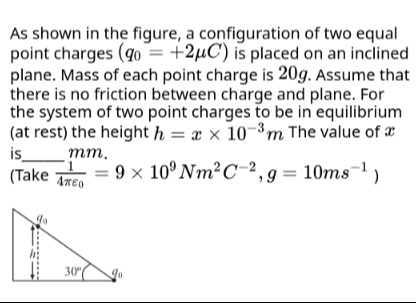Question
Question: As shown in the figure, a configuration of two equal point charges ($q_0 = +2\mu C$) is placed on an...
As shown in the figure, a configuration of two equal point charges (q0=+2μC) is placed on an inclined plane. Mass of each point charge is 20g. Assume that there is no friction between charge and plane. For the system of two point charges to be in equilibrium (at rest) the height h=x×10−3m The value of x is ____ mm. (Take 4πϵ01=9×109Nm2C−2,g=10ms−1)

300
Solution
To solve this problem, we need to analyze the forces acting on the upper point charge (q0) to ensure the system is in equilibrium. Since there is no friction, only gravitational force and electrostatic force are relevant along the inclined plane.
-
Identify the forces:
- Gravitational force (mg): Acts vertically downwards.
- Electrostatic force (Fe): Both charges are positive, so they repel each other. The electrostatic force on the upper charge acts upwards along the inclined plane, away from the lower charge.
-
Resolve gravitational force: The component of gravitational force acting down the inclined plane is mgsinθ.
-
Equilibrium condition: For the system to be in equilibrium (at rest), the electrostatic repulsive force must balance the component of gravitational force acting down the incline. Fe=mgsinθ
-
Express electrostatic force: The electrostatic force between two point charges is given by Coulomb's Law: Fe=kr2q02 where k=4πϵ01=9×109 Nm2C−2, q0 is the charge, and r is the distance between the two charges.
-
Relate distance 'r' to height 'h': From the figure, 'h' is the vertical height, and 'r' is the distance along the inclined plane between the two charges. The angle of inclination is θ=30∘. Using trigonometry, sinθ=hypotenuseopposite=rh. Therefore, r=sinθh.
-
Substitute and solve for 'h': Substitute the expressions for Fe and r into the equilibrium equation: kr2q02=mgsinθ k(h/sinθ)2q02=mgsinθ kh2q02sin2θ=mgsinθ Assuming sinθ=0 (which is true for θ=30∘), we can cancel one sinθ term: kh2q02sinθ=mg Now, solve for h2: h2=mgkq02sinθ h=mgkq02sinθ
-
Plug in the given values:
- q0=+2μC=2×10−6C
- m=20g=20×10−3kg=0.02kg
- k=9×109 Nm2C−2
- g=10 ms−2
- θ=30∘⟹sinθ=sin30∘=0.5
h=(0.02)×10(9×109)×(2×10−6)2×0.5 h=0.29×109×(4×10−12)×0.5 h=0.236×10−3×0.5 h=0.218×10−3 h=2×10−118×10−3 h=9×10−2 h=3×10−1m h=0.3m
-
Determine the value of x: The problem states that h=x×10−3m. We found h=0.3m. To match the format, convert 0.3m to 10−3m: 0.3m=0.3×1000×10−3m=300×10−3m. Comparing this with h=x×10−3m, we get x=300.
The question asks for the value of x in mm. This phrasing is ambiguous because x is defined as a dimensionless number in h=x×10−3m. However, it is common in such questions that the final numerical value is expected. If the question implicitly means "the value of h in mm is x", then h=0.3m=300mm, so x=300. In either interpretation, the numerical value of x is 300.
